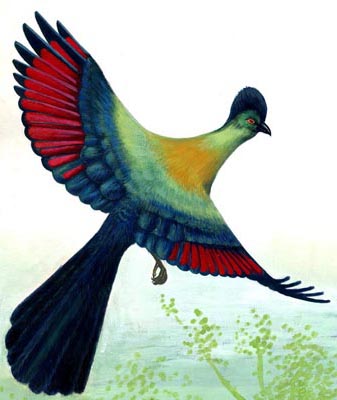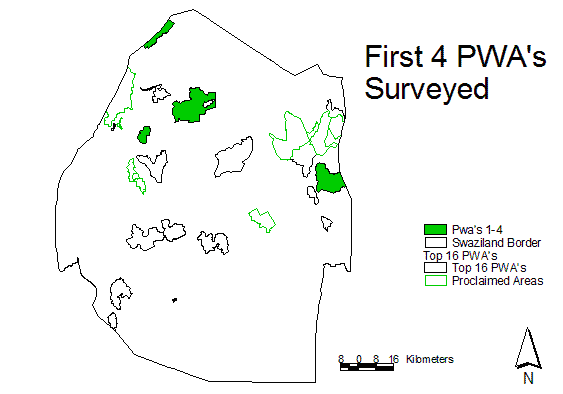The ENTC now has a new website, at www.entc.org.sz
Our logo is adapted from a painting by Phillip Dlamini, 1998, of a purple crested turaco. In traditional Swazi dress, the red feathers feature in the royal headdress, so this bird illustration is not only a symbol for wildlife conservation, but also of cultural heritage.


Information adapted from "A Preliminary Field Assessment Of Protection Worthy Areas Of Swaziland, Final Report", prepared By: K.G.Roques, June 2002, and "A Field Assessment Of Priority Protection Worthy Areas Of Swaziland, Makhonjwa, Manzimnyame, Sibebe And Nyonyane" compiled by K. Roques, L. Dobson, A. Monadjem, S. Dlamini, R. Boycott, T. Mahlaba and D. Raw, July 2003.
Despite a number of conservation planning exercises, Swaziland has a history of reserves being established in a relatively unsystematic manner. Swaziland's first reserve, Hlatikulu, was proclaimed in 1905, and it's second, Ubombo, in 1907 (Hackel & Carruthers 1993). The primary goal for these areas was the conservation of large mammal species. Up until 1917, these areas covered well over 10% of the country and appeared to be achieving their goal. Thereafter, an outbreak of Nagana (sleeping sickness) resulted in game being seen as a threat to the livestock industry and with concurrent economic recession, the majority of the area was de-proclaimed. By 1922 both reserves had been entirely de-proclaimed.
Forty two years later, following the near decimation of Swaziland's large mammals (Reilly 1994), the Kingdom's first existing reserve, Mlilwane Wildlife Sanctuary, was proclaimed under the Game Act of 1953. Later in 1967, Hlane Game Reserve was proclaimed under the same act. In 1972, the Swaziland National Trust Commission (SNTC) was formed specifically to conserve areas and features representative of Swaziland's natural and cultural heritage. As part of the establishment of SNTC, an initial assessment of protection worthy areas in Swaziland was done in 1972 (Grimwood 1973). The report was a first step towards developing a plan for creating "a pattern of [National] parks representative of all of the four main regions of Swaziland and covering as many as possible of the various ecosystems of each of them" (Grimwood 1973). Grimwood's work involved approximately 4 months of aerial and field based investigation. This report identified 6 protection worthy areas including Mlilwane and Hlane. Following this report, one of the proposed areas was proclaimed, Malolotja Nature Reserve, in 1977.
A second survey of national protection worthy areas was commissioned by SNTC in 1978 (Reilly 1979). The survey identified 31 protection worthy areas, including Mlilwane, Hlane and Malolotja, which would have resulted in protection of 9.47% of the Kingdom. Of this, 58% was proposed as National Parks, 13% as Nature Reserves, 24% as National Landscapes and 5% as National Wetlands. Only one of the 31 areas proposed was proclaimed, Mlawula Nature Reserve, in 1980. A fifth reserve, Mkhaya Game Reserve, was proclaimed in 1985 although it was not identified in either of the surveys. Two areas adjacent to existing reserves, Hawane (Malolotja) and Mantenga (Mlilwane) have since been proclaimed in 1992 and 1994 respectively. These total Swaziland's seven existing reserves, which cover 64100 ha, only 3.7 % of the country.
As part of the Ministry of Agriculture and Co-operatives' National Forest Policy and Legislation Project, another avenue for setting aside areas for the conservation of flora was created through the Flora Protection Act of 2000. This Forest Policy and Legislation Project commissioned a desk-top assessment of protection worthy areas in 2000 (Deale et al. 2000). This identified 11 areas in addition to the 30 previously identified (excluding proclaimed areas), and did a preliminary desk-top prioritisation of these 41 areas in terms of their conservation value.
Following Swaziland's ratification of the Convention on Biological Diversity in 1994, it developed a national Biodiversity Strategy and Action Plan (BSAP). This BSAP highlighted an urgent need for increased protection of representative examples of biodiversity, and conducted a preliminary field assessment of protection worthy areas of Swaziland, with the objectives of 1) to rapidly assess a set of identified areas in order to determine their conservation value, and 2) of these, to identify a set of top priority areas where field surveys should be done to collect necessary biodiversity information.
Areas worthy of considering for this study were identified based on 1) areas previously identified as protection worthy (Grimwood 1972, Reilly 1979, Deall et al. 2000) and 2) areas with virtually no human settlement considered to have potentially high biodiversity value by local biodiversity experts. Using these criteria, 44 potential PWAs were identified.
This rapid assessment involved brief visits to the 44 areas and later, an additional 12 areas, to prioritize them for further more detailed evaluation. The assessment highlighted 16 areas of high priority to be surveyed. This included nine areas of high overall priority (Mdzimba, Ntungulu, Nyonyane, Ndlotane, Mahuku, Jilobi, Shewula, Manzimnyame and Makhonjwa), with an additional two areas of biological priority (Mahamba and Muti Muti) and an additional five areas of socio-economic priority (Sinceni, Maguga, Sibebe, Gebeni and Panata).
Biological Importance
Socio-Economic Importance
Overall Importance
Overall Degree of Threat
Proposed Conservation Categories
List of areas:
Proposed categories of management for protected and protection worthy areas. Areas identified as having high priority are in bold.
| Proposed management category | Area name | Proposed Act for Proclamation |
|---|---|---|
| National Park | Hlane | ENTC |
| Malolotja | ENTC | |
| Mlawula | ENTC | |
| Mlilwane | ENTC | |
| National Mounument | Maguga | ENTC |
| Mantenga | ENTC | |
| Mdzimba | ENTC | |
| Sibebe | ENTC | |
| Nature Reserve (National) | Hawane | ENTC |
| Ntungulu | ENTC | |
| Mahamba | ENTC | |
| Nyonyane | ENTC | |
| Manzimyame | ENTC | |
| Sondeza | Flora Protection | |
| Shewula | ENTC | |
| (private) | Mbuluzi | Game |
| Mkhaya | ENTC | |
| Muti muti | Flora Protection | |
| Nisela | Game | |
| Protected Landscape | Bulembu | ENTC |
| Mahlangatsha | Flora Protection | |
| Mananga | Flora Protection | |
| Makhonjwa | ENTC | |
| Gebeni | Flora Protection | |
| Mhlumeni | Flora Protection | |
| Ndlotane | ENTC | |
| Nsongweni | ENTC | |
| Usutu gorge | Flora Protection | |
| Phophonyane | ENTC | |
| Sinceni | Flora Protection | |
| Tulwane | Flora Protection | |
| Resource Reserve | Mahuku | Game |
| Big Bend Conservancy | Game | |
| Jilobi | Flora Protection | |
| Hlane west | Game | |
| IYSIS | Game | |
| Panata | Game | |
| Pongola | Game | |
| Mjoli | Flora Protection | |
| Mkhondvo | Flora Protection | |
| Nkhalashane | Flora Protection |
The field assessment of priority protection worthy areas of Swaziland was commenced in 2003, with the survey of four selected areas, namely Makhonjwa, Manzimnyame, Sibebe And Nyonyane. It was recommended that the remaining 12 areas should be surveyed in similar detail in subsequent studies.

Roques, K.G., Dobson, L., Dlamini, S.D., Monadjem, A., Boycott, R., Mahlaba, T. and Raw, D. (2003) A Field Assessment of Priority Protection Worthy Areas of Swaziland: Makhonjwa, Manzimnyame, Sibebe and Nyonyane. Swaziland Environment Authority, Ministry of Tourism, Environment and Communications, Swaziland Government, Mbabane. (pdf format, 1.014 Mb)
Roques, K.G. (2002) A Preliminary Field Assessment Of Protection Worthy Areas Of Swaziland, Final Report. Swaziland Environment Authority, Ministry of Tourism, Environment and Communications, Swaziland Government, Mbabane. (pdf format, 613 Kb)
Our Contacts:
Head Quarters: (+268) 2416 1489/1179
Email: info@sntc.org.sz
King Sobhuza II Park: (+268) 2416 1489/1179
Email: ksmp@sntc.org.sz
National Museum: (+268) 2416 1489/1179
Email: curator@sntc.org.sz
Copyright © ESWATINI NATIONAL TRUST COMMISSION
Malolotja Nature Reserve: (+268) 2444 3241 / (+268) 2416 1480
Email: culturalvillage@sntc.org.sz
Mantenga Nature Reserve and Swati Cultural Village: 2416 1151/1178
Email: culturalvillage@sntc.org.sz
Mlawula Nature Reserve: (+268) 2383 8885 (Reception)
(+268) 2383 8453 (Senior Warden)
Email: culturalvillage@sntc.org.sz
Magadzavane Lodge: (+268) 2343 5108/9
Email: magadzavane@sntc.org.sz